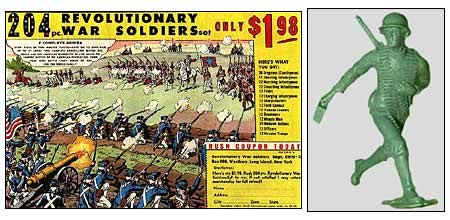Army Men

Synopsis of Toy
Toy trends come and go, but some old soldiers never die. In times of war, in times of peace, those valiant fighters we call Army Men have stood valiantly in place (probably because their feet are molded to plastic bases, but who are we to question their heroism?). Whether they come in a bag, a bucket or a playset, these plastic toy soldiers have been reliably popular with kids for over fifty years.
Modern toy soldiers are usually made of plastic, but the original toy soldiers were made of alloys like tin. They originated in Europe during the late 1800’s, with Germany, France and England taking the production lead. The initial soldiers had solid bodies, but later models were made in a hollow style that made them cheaper to manufacture. The average toy soldier was usually brightly painted, two to three inches in height, and tended to be sold in a group instead of by itself. Styles ranged from then-current soldier looks all the way back to Roman and Egyptian styles. They also came packaged with replicas of soldier accessories like wagons, artillery and even buildings.
Toy soldiers emigrated to U.S. factories around World War I. These figures—made of iron, and later of lead—usually consisted of the then-current “doughboy” soldier, as well as Civil War style soldiers. Cowboys and Indians were another popular style of figure made alongside these army men. A manufacturer in New Jersey added an innovation into the mix, giving the metal warriors “pod feet” (rounded flat discs where their feet would normally be). These figures continued to be popular until the 1950’s, when concerns over lead poisoning made it clear that toy manufacturers would have to find a new material for these figures.
The solution was plastic. Toy makers everywhere began turning out toy soldiers in their new plastic form, leading to the true beginning of what we now know as Army Men. They were easily and cheaply manufactured, so toy companies tended to sell them by the bag. Some manufacturers continued to use the molds designed for their lead figures, but others took advantage of the new level of detail that could be achieved with plastic, making newer, finely-crafted molds. The result was a high-quality toy that could be had for an economical price. Kids also enjoyed them because you could get many of them for a small price, meaning two very important things: First, you could afford to stage elaborate multi-soldier battles on the sandlot or in the living room. Second, since they were cheap, they were expendable, and many a toy soldier died an honorable death at the wrong end of a slingshot or BB gun.
Various companies produced Army Men, but a few stood out in terms of popularity. Marx Toys was the leader on the toy soldier front, selling their plastic combatants in bags and in playsets that also included accessories like vehicles, large-scale weapons, and structures for the soldiers to fight in. They also made these toys in several different styles: Knights Vs. Vikings, the Alamo, Fort Apache, Blue Vs. Grey (Civil War), and Battleground (World War II). Other popular manufacturers of Army Men included Timmee, whose plastic soldiers were made from old lead-soldier molds, and MPC, who made their soldiers with ring-shaped hands so they could hold a variety of interchangeable weapons.
The popularity of Army Men continued to be strong throughout the 1960’s, as new styles like the M-16 rifleman came into vogue. The companies that made Army Men also began making other styles of plastic figures like Knights, Pirates and Spacemen. Some even made Monster figures inspired by movie monsters and Dinosaurs. All these varieties also began appearing in comic book ads (“Two Complete Armies – Rush Coupon Today”) around this time. These ads became a very important in the 1970’s, when companies like Marx began to fold. This led to an Army Men scarcity on toy shelves, making the ads a vital way for toy fans to get these items.
During the 1980’s, the popularity of toy soldiers suffered due to the fact that they weren’t easy to find, along with the boom in other war-related toys like G.I. Joe. Just the same, Army Men never went away: they were just marking time until their next comeback. In the 1990’s, Army Men returned to prominence through appearances in kid-related hit films like Toy Story and Small Soldiers. Their popularity was further increased by a series of video games called Army Men, which brought these warriors into the high-tech era. This new renaissance proves that Army Men are truly a toy for the ages. Battle on, plastic ones...
Release History of Toy
late 1800's - tin soldiers1950's - plastic Army Men
